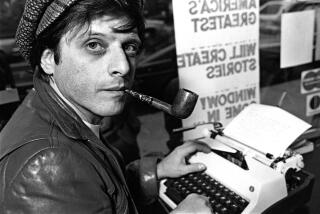Amnesia makes David Stuart MacLean a ‘Riddle’ he must solve
- Share via
One day, David Stuart MacLean forgot who he was. “It was darkness darkness darkness, then snap. Me. Now awake.” He was a blank slate, standing in a bustling train station in India. Things went downhill from there.
From these dark days, MacLean has created a deeply moving account of amnesia that explores the quandary of the self.
The book’s short, episodic sections are particularly well suited to evoking the hellish psychosis MacLean endures after “waking up.” These disorienting snippets of experience offer little reflection, context or connective tissue. Has it been a day? A week? Who is this narrator, and how did he end up here? MacLean has hallucinations and memory lapses, flitting in and out of consciousness like a surrealist television show playing on a set with a haywire power button.
“I’d black out and then snap back awake in no discernible pattern.” He is bumming cigarettes from someone who might be Jim Henson; he is teaching English to a boy perched on his bed; he is wrestling “with the riddle God had given me, the quatrain he’d asked me to recite, the one that was the secret code into the fourth dimension.”
MacLean’s worried parents come to India and find their son in a psychiatric hospital, untethered from reality and heavily medicated, his condition likely triggered by taking Lariam, an antimalarial medication. (Although the drug is no longer available in the United States under the brand name Lariam, generic versions of mefloquine are available.) His parents take him home to Ohio, where he begins the arduous journey back to himself.
The book’s fractal style continues to serve MacLean’s story as he struggles to piece himself together. He discovers he is a writer who was in India on a Fulbright, an impish, slightly manic, wildly inventive jokester. He goes from Ohio back to India, then to New Mexico, where he is a graduate student. He drinks heavily, alienates his girlfriend and feels like a “fungible soul” — anyone and no one. “All I had to go on for my identity was the reactions of the people arrayed around me. I assembled a working self out of the reactions of others.”
As he searches for clues to his identity in old photographs and the marginalia of novels he no longer remembers reading, the short sections take on a broader range — chronological episodes are juxtaposed with musings on a favorite short story or the history of mefloquine. The identity of the narrator expands beyond the present moment.
But MacLean doesn’t always like what he finds. When he tells friends he has amnesia, they think it’s a prank. What sort of person fakes amnesia? When a woman at a party tells him he doesn’t respect women, he asks his mother if it’s true. “The real problem,” she responds, “is that it makes it seem like you respect men.” She calls him an “equal-opportunity jackass.” When he finds an unused train ticket, he realizes he intended to cheat on his girlfriend. “I was a divided self already.”
But to what extent would any of us, if forced to see ourselves as if from outside, like the person we see? Memory has a way of smoothing rough edges in the story we each tell ourselves about who we are. This could be called a quirk of the brain or a survival technique. For MacLean, learning to tell his own story again is tantamount to staying alive.
This memoir is often funny, but it is also a gripping account of one man’s midnight of the soul. At his nadir, MacLean aches for the “warm womb of a hospital room, the sharp scrape of a plastic spoon hitting the bottom of a plastic bowl as someone feeds you curd rice, let you be born again, hit the button and be reset again. You got it wrong this time.” Although his vantage point is specific, the valley he looks out on is familiar. He is describing the dark places that any of us could go.
His descriptions of nearly unimaginable states — psychosis, amnesia, depression — succeed because MacLean is a master of analogy. Trying to reconstruct his identity is “like building a plane while flying in it.” The main characters of “The Fugitive,” “Kimble chasing after an old life and Gerard chasing after Kimble” are like “Job vs. Eeyore,” and if you “cram them into your brain at once, then you have what recovering from amnesia feels like.” Over and over, he demonstrates that analogy is the bridge by which we move from the known to the unknown. He uses it to bridge the gap between his harrowing experience and the reader’s imagination, ultimately offering insight into our shared humanity.
Books and movies, in particular, serve as touchstones, because they contain what is like, and not like, MacLean’s experience. He goes to them in search of mirrored shards that might, eventually, be arranged so that he can see himself, or someone like himself, reflected back: a man who is similar to but not the same as the man he used to be.
MacLean has written a memoir that combines the evocative power of William Styron’s “Darkness Visible,” the lyric subtlety of Michael Ondaatje’s “Running in the Family” and the narrative immediacy of a Hollywood action film. He reminds us how we are all always trying to find a version of ourselves that we can live with.
Crist is writer-in-residence in biological sciences at Columbia University. She is working on a book about traumatic brain injury.
The Answer to the Riddle Is Me
A Memoir of Amnesia
David Stuart MacLean
Houghton Mifflin Harcourt: 304 pp; $25
More to Read
Sign up for our Book Club newsletter
Get the latest news, events and more from the Los Angeles Times Book Club, and help us get L.A. reading and talking.
You may occasionally receive promotional content from the Los Angeles Times.






